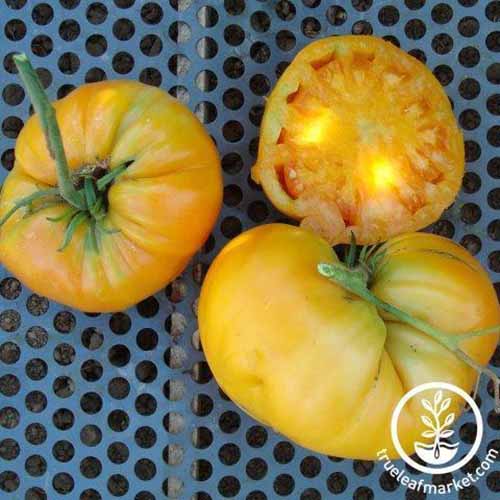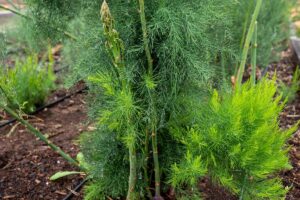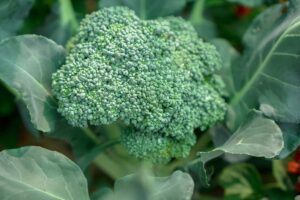Solanum lycopersicum ‘Kellogg’s Breakfast’
Wait, ‘Kellogg’s Breakfast’ tomatoes?
I bet you’re wondering how an heirloom tomato came to share a name with cereals that feature iconic toucans and tigers on their box fronts.
I have an explanation, and I’ll share it, but there are a couple of more important things a home gardener should know about ‘Kellogg’s Breakfast.’
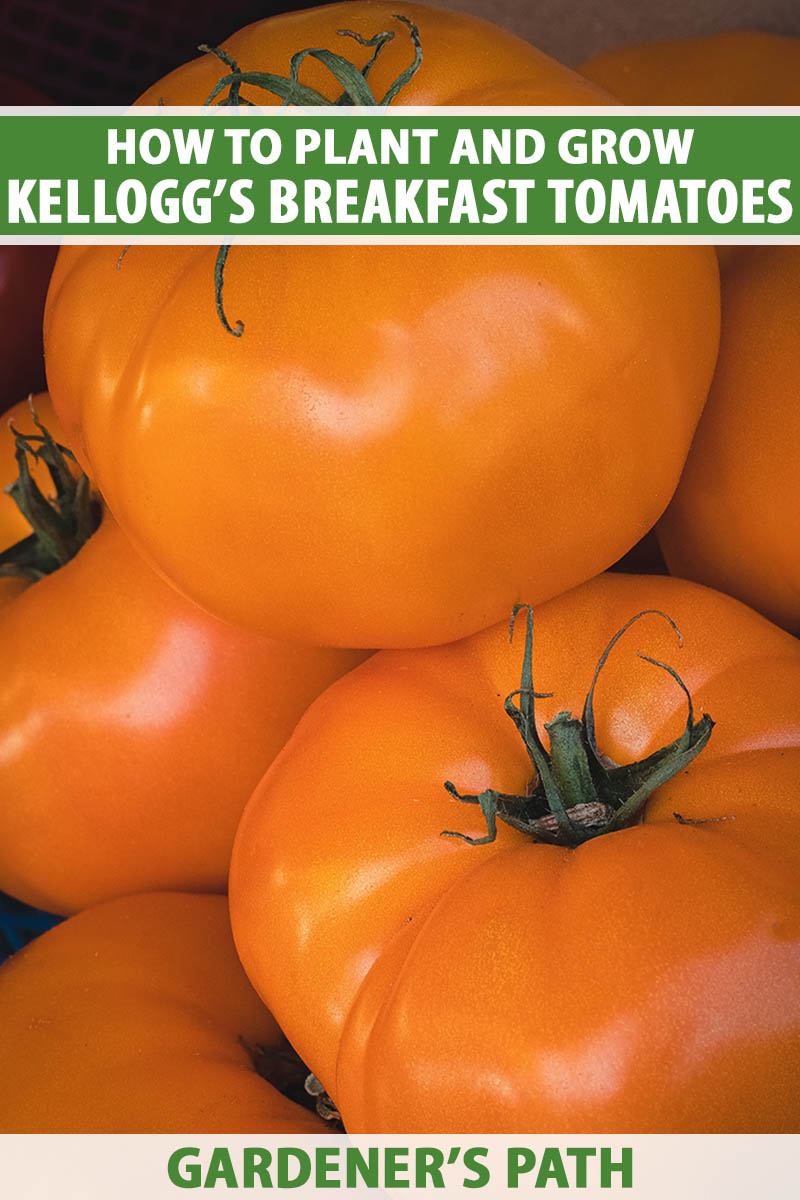
We link to vendors to help you find relevant products. If you buy from one of our links, we may earn a commission.
This cultivar produces juicy tomatoes that weigh 16 to 32 ounces each. They’re sweeter than most beefsteaks but they also deliver that deep, “true tomato” taste many home gardeners remember from the old days.
And ‘Kellogg’s Breakfast’ tomatoes are unapologetically orange, a true orange from the skin to the firm flesh.
They don’t just taste great sliced into salads, sandwiches, and BLTs, they liven up the presentation with their dashing color as well.
The plants are indeterminate, meaning they’ll produce from the time they mature until cold weather sets in.
Based on my experience, they’re more productive than a lot of heirloom varieties, and a few seed vendors that I trust agree.
Still, this type of vining, or pole, tomato won’t work well for all gardeners. If you live in an area where the growing season is short, you’ll have to plan carefully to have enough time for this mid- to late-season cultivar to yield.
It takes a good while from transplant to harvest, about 80 to 85 days.
If you already grow vegetables vertically, this variety will fit right into your vegetable garden plan. But if you aren’t set up for trellising or prefer bush varieties or short vines, ‘Kellogg’s Breakfast’ might be hard to handle.
It will require substantial support for the healthy plants, which can reach seven to 10 feet tall, and fairly scoff at the three-foot tomato cages.
It would do okay in a container, but only one that holds at least seven gallons, and it still needs a sturdy, tall fence, cage, or stake when grown in a raised bed or pot.
If you have a conflict or two with its growth habit, the massive fruits are so full of that elusive “real tomato“ taste I think you still might find it worth the extra effort.
And by focusing on its specific needs, you can grow the healthiest ‘Kellogg’s Breakfast’ plants and maximize their yields.
Want some more info before you decide to give it a go?
I’ll share that origin story and plenty of growing tips in this guide. Here’s what to expect:
What You’ll Learn
What Are ‘Kellogg’s Breakfast’ Tomatoes?
‘Kellogg’s Breakfast’ beefsteak tomatoes grow on indeterminate, regular-leaf vines that can reach eight to 10 feet tall.
The fruits are hefty, weighing one or two pounds each at full size. They’re easy to distinguish from others, with their carrot-orange color.

The taste is a burst of sweetness balanced with a touch of acidity to create that elusive “true tomato” taste home chefs and nostalgic country folks long for.
Like all cultivars of the S. lycopersicum species, these tomatoes are descended from plants native to South and Central America.
Wild tomatoes can be traced back to at least 7,000 BCE, and there is evidence of humans cultivating these vegetables for their own consumption as far back as the ancient Mayan civilization around 2,500 BCE.
As for this particular heirloom, both halves of that name can leave you scratching your head, so I’ll address them separately.
First, “Kellogg’s.”
This variety was first cultivated in West Virginia but was later selected by a faithful, enthusiastic amateur seed saver from Redford, Michigan.
This man, Darrell Kellogg, made a living as a railroad supervisor, but he was dedicated to heirloom tomatoes. Kellogg grew this type and saved the best seeds for more plants until he felt comfortable naming it after himself.
He shared with Bill Minkey of Wisconsin, who introduced the seeds to the non-profit Seed Savers Exchange in 1993. Grassroots heirloom growers swap and sell the seeds still.
This tomato is not tied to billionaire industrialist and philanthropist William Keith Kellogg, the man who is credited along with his brother with the invention of flaked breakfast cereal. His breakfast cereal empire was founded in 1906.
W. K. Kellogg also hailed from Michigan, though he rose to fame and fortune in Battle Creek, not Redford.
This brings us to breakfast. Why is this heirloom cultivar also associated with the most important meal of the day?
In my extended family, we eat tomatoes for breakfast all summer, but that wasn’t the thought behind naming this heirloom.
I don’t know if you’ll agree with this assessment, but the breakfast label probably came from Kellogg thinking the tomato’s color resembled the hue of another breakfast staple: orange juice.
Or so the story goes – but most fans of this variety, as well as Bill Minkey, the Seed Savers Exchange, and Darrell Kellogg himself seem to leave out any mention of OJ, at least from anything resembling an official source that I was able to track down.
This vague background leads to my hope we won’t worry too much about the name, not when there’s a luscious orange heirloom tomato available that will thrive in the average garden, with seeds to plant and not a minute to waste.
Let’s get growing!
Propagation
Unless you know you have a reliable source for locally grown ‘Kellogg’s Breakfast’ starts, you’ll need to plan ahead to start your own from seed.
These aren’t one of the summer-grown vegetables one sows directly into the garden because the seeds only germinate in soil temperatures above 50°F.
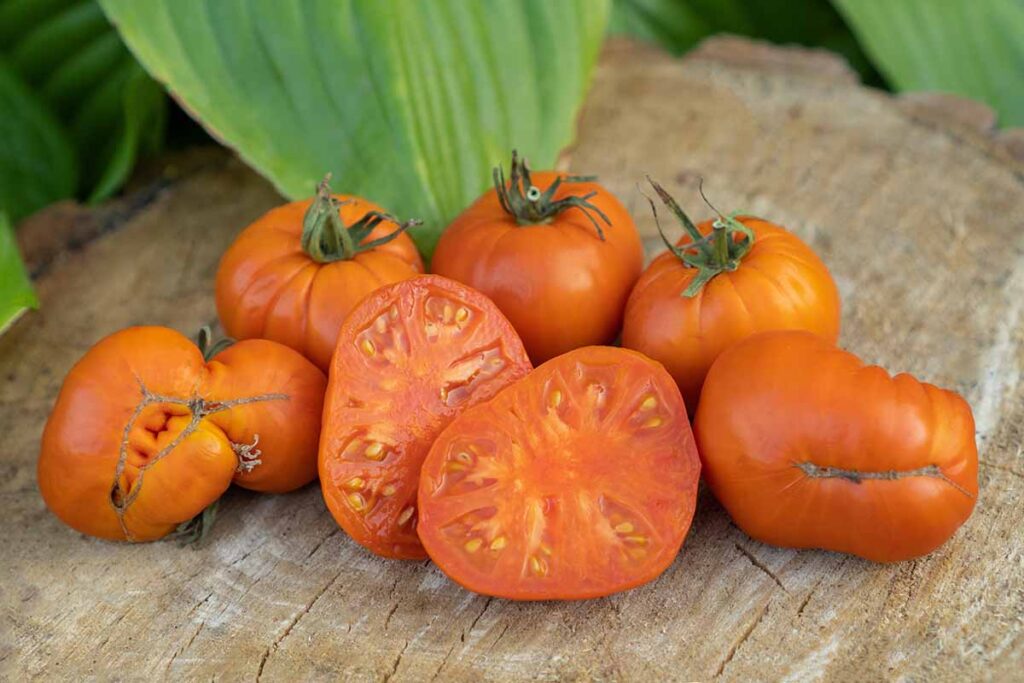
By the time it’s warm enough to sow them outdoors, you probably won’t have enough time for them to spend about five weeks growing into four- or five-inch seedlings, and another 80 to 85 days to produce ripe fruits.
Instead, sow the seeds indoors four to six weeks ahead of transplanting them outside when it’s warm enough.
You can find a handy guide to growing tomatoes from seed here, but I’ll give you the basic run-down:
Start with a tray that has drainage holes or individual cells and fill it with a couple inches of specially-formulated seed starting mix or potting soil amended with perlite or sand to make it lighter.

I like these 24-cell trays from Ryscam via Amazon because they make it possible to bottom water the sprouts and to pop the seedlings out readily by pushing them up from beneath the tray at transplant time.
Place the tray or cells on a solid tray so you can bottom water, and it will catch any excess moisture.
Moisten the soil ahead of sowing, but don’t let it get too wet.
Sow the seeds a quarter-inch deep and cover the cells or tray with a clear dome or plastic wrap. Place them in a spot that’s about 70 to 75°F for optimal germination. If your home is chilly like mine, you may want to use a heat mat.
Make sure the soil stays moist until the seedlings break through. Take the dome off or remove the plastic, and reposition the cells or tray beneath a grow light or on a sunny windowsill where it can get at least four hours of strong light each day.
If you used a mix specially formulated for seed starting, the seedlings won’t need any fertilizer until you’re ready to plant them out. And you’ll do this when they’re at least four weeks old and have several sets of true leaves.
If you used regular potting soil, they might benefit from a diluted liquid fertilizer applied when they’re a couple of inches tall.
One other thing. You probably won’t be this fortunate (I never have been), but if you have a friend with a larger live plant, you can ask for a cutting to root.
This is especially helpful if it’s later in the season and you started too late for sowing seed indoors. To root a cutting, follow the instructions in our guide to growing ‘Costoluto Genovese’ tomatoes.
When the seedlings or rooted cuttings are big enough to transplant, time the move for a day when the soil temperature is at least 50°F and the air is reliably 60°F or warmer in the daytime and consistently at least 50°F at night.
If you need a jump start in chilly spring weather, consider using cold frames. Our guide will teach you how to use them to start your plants early.
Be sure to introduce homegrown seedlings or rooted cuttings to outdoor conditions gradually, exposing them to more light and outdoor temperatures over the course of a week before transplanting.
When you do put the starts into the soil, bury the stems up to the point where only the top two sets of true leaves are showing.
This odd tactic will promote stockier plants and healthier roots, even though it will prevent your vines from growing more than a few inches tall in the first couple of weeks.
Once you’ve got the plants in the soil and watered them, you’re well on your way to a successful harvest.
It will take at least 80 days, but you’ll only need to keep up with watering and a bit of mulching and fertilizing.
Let’s look at the best way to grow ‘Kellogg’s Breakfast’ tomatoes from transplant to harvest.
How to Grow ‘Kellogg’s Breakfast’ Tomatoes
Growing heirloom tomatoes is a great way to relax, spend time outdoors, and stretch your grocery budget with homegrown food.
And it’s not that tough, as long as you take steps to set yourself up for success.
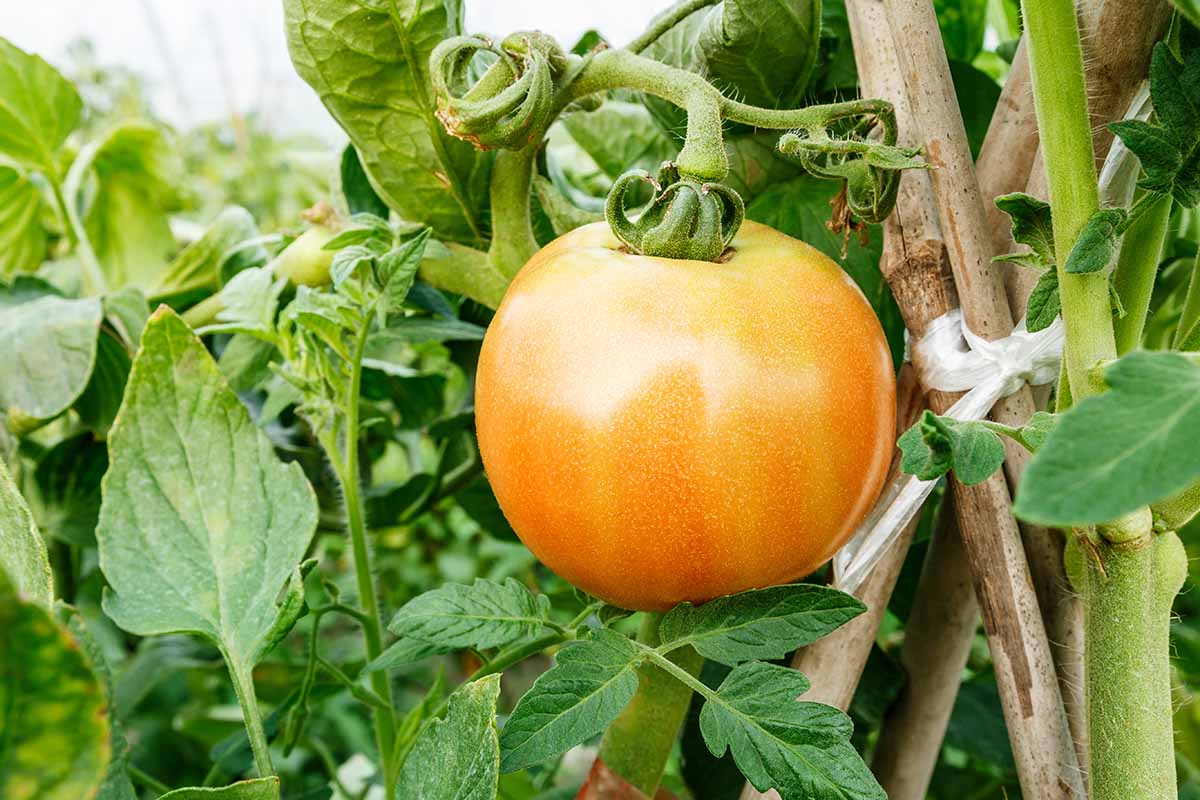
Location is key. Like all S. lycopersicum varieties grown in summer veggie gardens, ‘Kellogg’s Breakfast’ needs six to eight hours of full sun per day.
The soil should be in the pH range of 6.0 to 6.8, well-draining, and amended with two inches of aged manure or nutrient-rich compost ahead of planting.
When you grow these pole tomatoes in a container, you’ll need to choose a pot with drainage holes that can hold at least seven gallons of potting soil.
Be advised that a pot that big is quite heavy when it’s full. Container-grown indeterminate beefsteaks also require extra fertilizer later in the growing season, and supplemental water several times a week in the hot months.
You can find more advice for growing tomatoes in containers in our guide.
For garden or raised bed plants, be careful to choose a spot where you haven’t grown other tomatoes or fellow nightshades – potatoes, eggplant, or peppers – in the past three seasons. That will help you to avoid diseases and pests.
Plan out which supports you’ll use for these tall vines in advance. Install stakes or trellises ahead of transplanting, and cages as you plant the seedlings.
I know I said this already, but they’ll need to be big, tall cages, at least six feet high, or ‘Kellogg’s Breakfast’ will outstrip them in a matter of weeks and start toppling over.
You may also want to place a taller bamboo stake within a cage to accommodate any vines that grow taller than six feet.
Space the plants two feet apart in the garden, and allow three or four feet between rows. This gives you room to weed, water, and harvest, and gives the plants ample space for air circulation that promotes growth and discourages diseases.
You’ll want to weed before you plant the seedlings so they’re not competing with weeds that grow faster than they do.
Once they’re four to six inches tall, you can discourage weeds and help retain moisture by mulching with two inches of untreated grass clippings, or my favorite, pine straw.
From there, you’ll move into maintenance mode up until harvest.
You’ll want to water the plants whenever rain doesn’t provide at least an inch of water per week.
Drip irrigation and soaker hoses work best since they prevent the leaves from getting wet and incurring waterborne diseases.
But you can also simply use the garden hose or a watering can, as long as you aim the water at the soil line and avoid splashing the leaves by watering overhead.
Later in the season, once the green fruits start appearing, you may want to apply a 5-10-10 NPK fertilizer.
Dilute fish emulsion or a compost tea brewed from homegrown comfrey are both good choices.

Master Nursery Granular Fertilizer
I sometimes use Master Nursery granulated fertilizer, available in five-pound bags via Amazon.
Turn to our general tomato growing guide for more advice on caring for these heirloom favorites, including tips on pruning.
Growing Tips
- Choose a planting area that receives six to eight hours of full sun daily.
- Amend the soil with rich, composted organic matter ahead of transplant.
- Install substantial trellises or cages during transplanting or soon after.
- Use drip irrigation or soaker hoses, or water at the soil surface with a hose or watering can.
- Apply 5-10-10 NPK fertilizer when the plants start to set fruit.
Where to Buy ‘Kellogg’s Breakfast’ Tomato Seeds
‘Kellogg’s Breakfast’ often shows up on the short list of favorites that regional master gardeners and ag extension offices compile, but you’ll probably have trouble finding live starts for sale.
I would recommend making some calls to local nurseries to find out when they’ll start selling heirloom tomatoes and asking whether ‘Kellogg’s’ will be offered.
If you discover a source, buy yours as soon as you can – heirloom plants of any description sell out quickly, and this one will be snapped up.
Depending on your state’s laws covering individuals selling or trading vegetable plants, you may also be able to find starts for this heirloom at the farmers market or a community plant swap.
Browse early and often, and don’t delay if you see the plants available – you’ll have competition, for sure.
Growing your own from seed is the most reliable way to acquire ‘Kellogg’s Breakfast’ transplants. Happily, there are several trusted sources for these particular seeds.
Sow Right Seeds offers 25-seed packets via Amazon and 30-seed packets are available from Park Seed via Amazon.
If you feel you’ll need more or are planning to freeze some extras to grow successive crops over the next couple of seasons, you can find a 65-seed packet available from True Leaf Market.
True Leaf Market also offers ‘Kellogg’s Breakfast’ seeds in bulk, so if your aspirations include growing a huge supply for the market or a community garden, or you’d like to share the seeds far and wide, you can find sacks containing thousands of seeds there as well.
Managing Pests and Disease
The strategies described here will all help to keep your tomatoes pest- and disease-free, but you may still encounter some foes.

Tomato hornworms may do some damage. Consult our guide to learn ways to detect and eliminate these impressive but destructive caterpillars.
Also beware of aphids and slugs, and be sure to check out our guides to each pest so you can recognize their presence in your garden and take steps to combat and prevent them.
Fungal and bacterial pathogens may also come to call, and a few physiological disorders including the puckered seams that result from catfacing.
You can learn ways to prevent and detect catfacing in our guide.
And be sure to check out our advice for handling all the most common tomato diseases.
Prevention and early detection are the best strategies for avoiding damage to your crop, and this guide has loads of tips for conscientious vegetable gardeners.
Harvest and Storage
Whether you have a plant or two, or a 30-foot row of ‘Kellogg’s Breakfast,’ reaching the harvest stage is cause for celebration.
Mind you, it takes a while. This variety doesn’t take as long as some other heirlooms – ‘Hawaiian Pineapple’ doesn’t start ripening until 90 days from transplant, for example.
You can still anticipate the passing of at least 80 days from transplant to picking ripe fruits, and add an extra week or two if the temperatures start to exceed 85°F.
For detailed advice on encouraging stubbornly green fruits to ripen when it’s past their anticipated maturity date, see our guide to ripening tomatoes.
They’ll taste best if you leave them on the vine to ripen fully, but you can also pick them a couple of days early and let them continue to ripen on the counter.
To remove the fruit from the vine, gently twist it where it meets the stem until it drops into your hand.
Once the fruits start getting ripe, pick each one as soon as it’s ready. Overripe fruit is a bee and fly magnet, and it will rot quickly if it falls to the ground.
Inside, make sure to use fresh fruits as quickly as you can. Don’t refrigerate unripe fruit or the ripening process will halt there and then. Instead, leave them on the counter at room temperature and out of the direct sun.
You can store fully ripe tomatoes in the fridge for three or four days, but before you use them, allow them to come to room temperature for 12 hours.
You can also store tomatoes longer in boxes and via other methods.
Get the scoop on the different ways to keep your precious harvest fresh as long as possible in our tomato storage guide. And read on for ways to preserve ‘Kellogg’s Breakfast.’
Preserving
When you grow sizable slicing tomatoes like these, they’ll always be at their tastiest if eaten fresh – and consumed as quickly as possible after picking.
But that doesn’t mean you can’t also preserve the extras if you have an overabundance of ‘Kellogg’s Breakfast.’ Or if you grew a whole bunch on purpose so you could stock up!
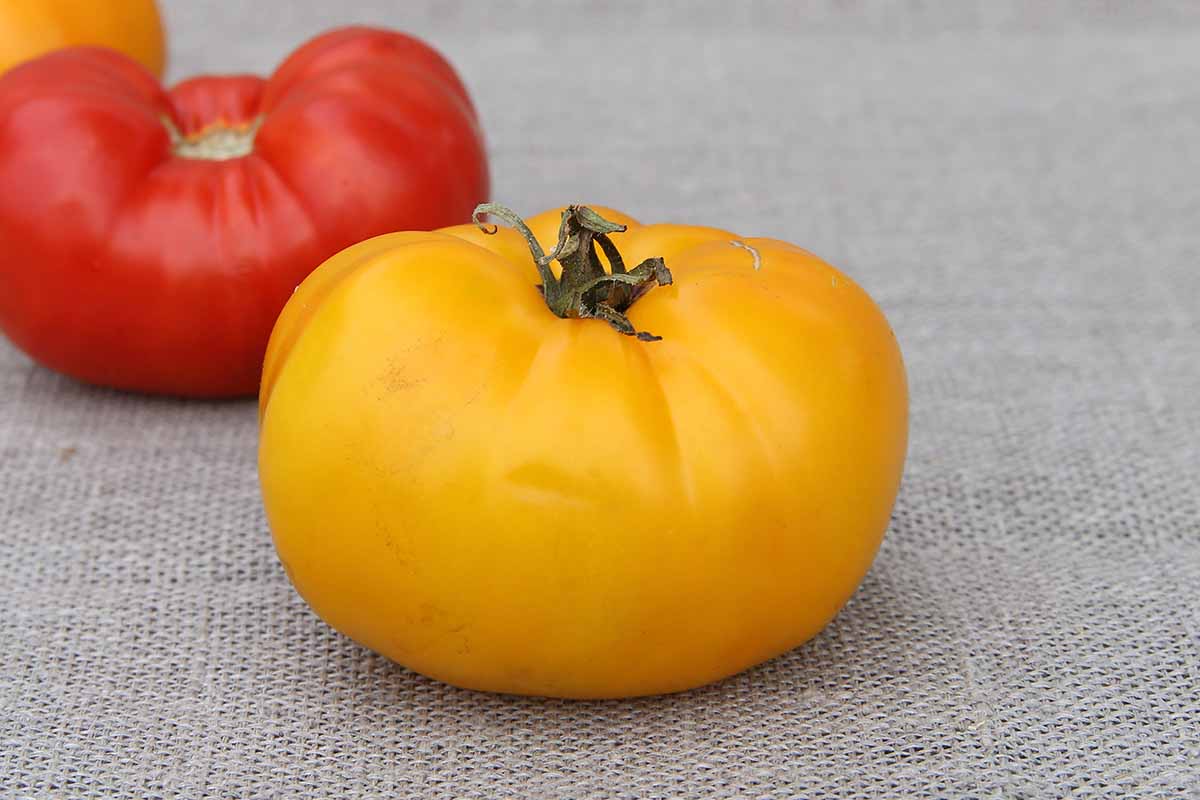
My top choice for preserving would be to cook more involved recipes that have tomatoes as an ingredient and freeze those dishes for later use.
This version of Italian lentil soup from our sister site, Foodal is freezer-friendly and calls for tomatoes.
Use chunks of peeled (and seeded if you like) ‘Kellogg’s Breakfast’ in place of the canned tomatoes called for in this recipe.

Freeze portions sized to suit your family’s eating habits, and reserve the spinach called for in the recipe to add after you thaw and reheat the soup.
The next best alternative is to can or freeze recipes that are usually made with paste tomatoes, but are still quite tasty with an heirloom beefsteak in the mix.
Make salsa, for example, and then either can it with a water bath canner or freeze some for later use.
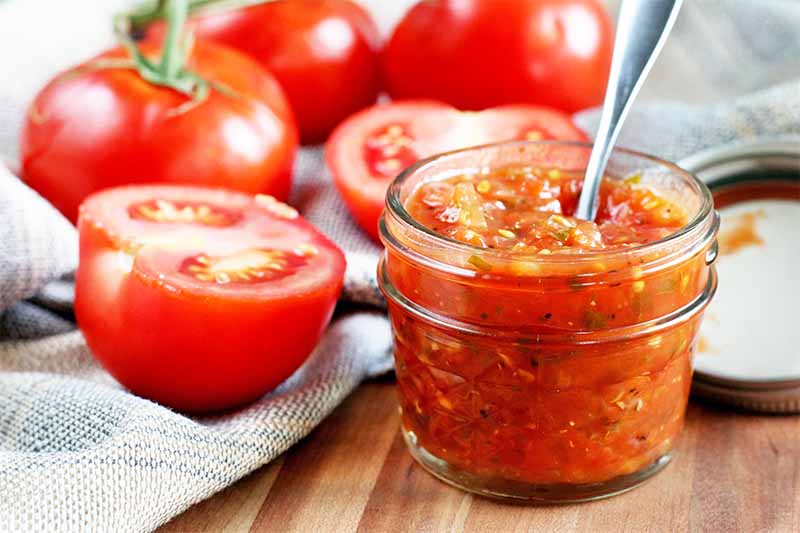
You can also make a rich and sticky jam with your heirloom orange tomato harvest. Follow Foodal’s basic recipe, and consider freezing small containers, leaving an inch of space at the top for expansion.
You can also dehydrate this variety or freeze whole tomatoes or chunks. Thawed, they’ll be too mushy to add to salads but still perfectly tasty popped into sauces, stew, soup, or chili.
You’ll find step-by-step instructions for freezing tomatoes in our guide.
Recipes and Cooking Ideas
Even though it takes several months of effort to grow ‘Kellogg’s Breakfast’ from seed or transplants, at harvest time, it still seems almost magical to have these massive heirloom tomatoes to eat fresh and cook with.

They are delicious, whether you eat them sliced on sandwiches, chunked into a garden salad, or marinated in your favorite vinaigrette for a brunch or dinner side dish.
You might even want to pay homage to their cultivar name and serve them at breakfast.
Our family’s Appalachian kin keeps one dish of sliced tomatoes and another of sliced cantaloupe in the fridge, ready for the morning meal.
Family members eat them alongside home fries or scrambled eggs, or tuck them into a fried egg sandwich to enjoy on the way out the door – the tomatoes, not the cantaloupe!
Simply chopping the tomatoes, whether or not you peel or seed them first, gives you loads more options, from fresh salsa to gazpacho to taco toppings.
You can also slice them extra thin, no more than a quarter inch thick, and slip the rounds into a panini or grilled cheese ahead of cooking it. That’s just enough fresh tomato to punch up the flavor without making the bread soggy.
Carrying the breakfast theme into brunch favorites, you can use ‘Kellogg’s Breakfast’ to make a fresh bloody mary with an appealing orange hue.
Use your favorite ingredients like hot sauce or Worcestershire, but replace the typical canned or jarred tomato juice with a fresh-pressed version.
To juice a tomato, remove the stem and cut it in half. Set a cocktail strainer or colander over a measuring cup or cereal bowl, and press the cut sides into the surface, skin side up, using the heel of your hand. This will remove the skins, strain the seeds, and catch the juice below.
I usually save the pulp left in the strainer to add to salsa or gazpacho, but you can also add it to the compost.
They’re also delicious enjoyed fresh in pasta salads, but you may want to drain them in a colander after cutting them into chunks so they don’t make the dressing too watery, especially if your recipe calls for the tomatoes with drier flesh, like ‘San Marzano.’
If you don’t already have your own version of pasta salad at the ready, here are two recipes you can make on repeat for cookouts and weekday lunches all summer long:
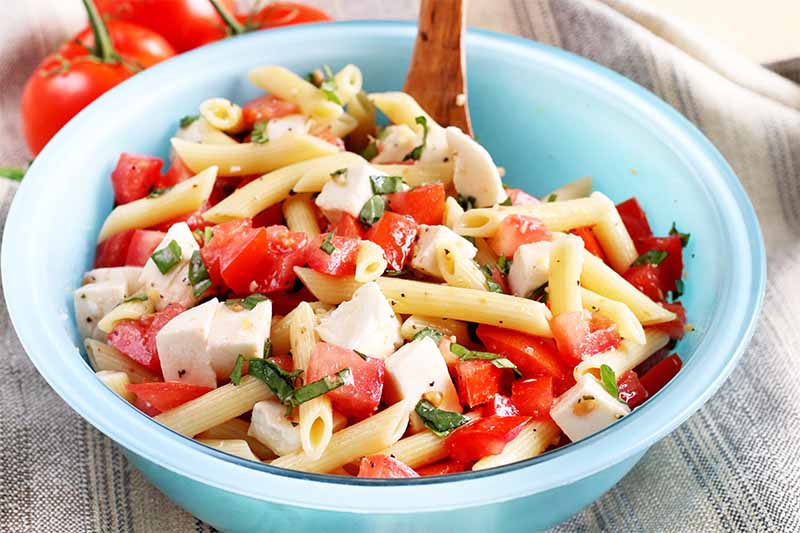
First, Foodal’s recipe for fresh tomato pasta salad borrows fresh mozzarella and homegrown basil ingredient from a traditional caprese salad, while a ranch BLT pasta salad, also from Foodal, ratchets up the flavor with the addition of the popular salad dressing and crispy bacon.
When you cook with ‘Kellogg’s Breakfast,’ remember that these have higher water content and need extra simmering time in tomato sauce, chili, and the like.
To use them as a pizza topping or tart ingredient, slice them into thin rounds and then quarter the slices so they’ll approximate the size of sliced plum tomatoes.
This heirloom will be more moist and less chewy after grilling or roasting than the typical Roma, but trust me, it will still taste delicious.

To experiment with ‘Kellogg’s Breakfast’ in place of tomatoes with thicker flesh and skins, an easy grilled caprese naan pizza is weeknight-quick and offers endless options, depending on which ingredients you have in the fridge. Find the recipe on Foodal.

And Foodal’s recipe for a tasty tomato tart made with a spelt crust is a savory baker’s delight that makes good use of any fresh basil you’re harvesting at the same time.
Quick Reference Growing Guide
| Plant Type: | Annual vegetable | Tolerance: | Heat |
| Native To: | Central and South America | Maintenance: | Moderate |
| Hardiness (USDA Zone): | 8-10 | Soil Type: | Organically rich loam |
| Season: | Mid- to late summer | Soil pH: | 6.0-6.8 |
| Exposure: | Full sun | Soil Drainage: | Well-draining |
| Time to Maturity: | 80-85 days | Companion Planting: | Basil, beans, carrots, chives, garlic, marigolds, nasturtiums, onions, parsnips, oregano |
| Spacing: | 24 inches (plants), 36-48 inches (rows) | Avoid Planting With: | Brassicas including broccoli, cabbage, and kale; corn; potatoes; shorter sun-loving annuals |
| Planting Depth: | 1/4-inch (seeds), level with second set of true leaves (transplants) | Family: | Solanaceae |
| Height: | 6-10 feet | Genus: | Solanum |
| Spread: | 24 inches | Species: | Lycopersicum |
| Water Needs: | High | Cultivar: | 'Kellogg's Breakfast' |
| Common Pests: | Aphids, armyworms, hornworms, slugs, snails, stink bugs, thrips | Common Diseases: | Anthracnose, black mold, blight, blossom end rot, catfacing, Fusarium wilt, mosaic virus, powdery mildew, Verticillium wilt |
Orange Tomatoes with Your Orange Juice?
My ongoing love affair with heirloom tomatoes started about 13 summers ago, and in the time since, I’ve grown at least a dozen varieties.
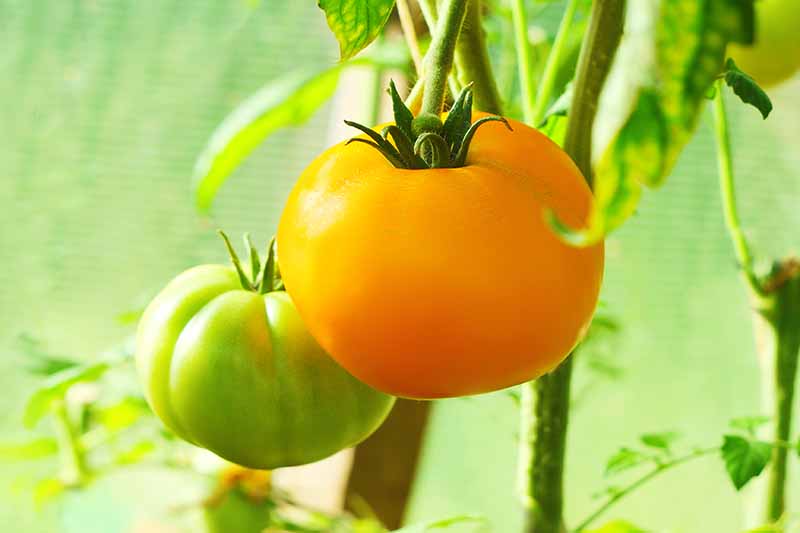
Over the years, I’ve learned to balance the rich tomato flavor and pull of nostalgia offered by the heirlooms against the usually improved disease resistance and higher yields of certain hybrids.
I usually limit myself to just half a dozen heirloom plants, so I’ll have more room for prolific canning tomato varieties, but a couple of ‘Kellogg’s Breakfast’ plants are usually in the mix.
For me, they’re a notch above others I could grow because the flesh of the tomatoes is both firm and juicy, they produce about 50 percent more fruit than other beefsteak heirlooms, and the vines fit into my vertical gardening scheme.
The fruits being orange-colored is another bonus. I like to grow the unexpected!
If you have experience with or questions about ‘Kellogg’s Breakfast,’ kindly add your input to the comments section below.
And if you’re intrigued by the different hues of various tomato plants, read these colorful guides next:
